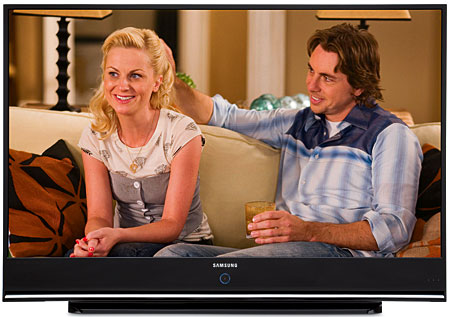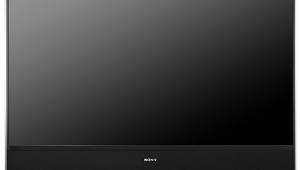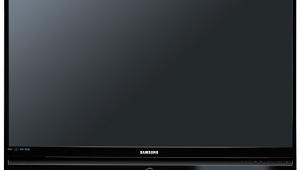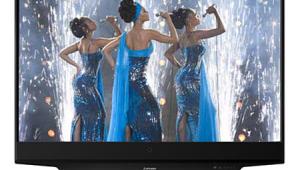Samsung HL61A650 Rear Projection HDTV

Features
At 61 inches diagonal, the Samsung is the smaller member of this two-set match-up, but it’s still considerably larger than most comparably priced flat panels. Also, like the Mitsubishi, you’ll be surprised at how light it feels. Even better, the price will also be light on your wallet.
The set provides an adequate number of inputs, including a WiseLink port—Samsung’s name for the USB connection that lets you view JPEG photos, listen to MP3 audio files, and input possible future firmware upgrades.

There are three picture modes: Dynamic, Standard, and Movie. The controls for each of these modes are adjustable (with some limitations) and also separately adjustable for each input. I chose Movie mode for most of this review, since it produces the most natural-looking image in subdued room lighting—the type of lighting most likely to be used for serious viewing.
Beyond the normal video controls, the Samsung adds a number of “enhancements.” Black Adjust appeared to do little more than crush the blacks. This can be corrected by readjusting the Brightness control, which almost gets you back to where you started. Dynamic Contrast made both the peak white output (which the set didn’t really need) and the black level (which the set definitely didn’t need) brighter.
There are five different color temperature options. Warm1 and Warm2 are only available in Movie mode. Warm2 was by far the most accurate on my sample. Thankfully, Samsung’s DNIe feature is only available in Dynamic—a mode no videophile would ever use.
The gamma control offers seven different settings. The white balance control can tweak the color temperature from the preset options. As a single control, though, it’s an odd duck, particularly since the service menu offers much more sophisticated white balance/gray scale adjustment options. Flesh Tone was best left off, and Edge Enhancement appeared to have little effect.
 The color gamut control offers two options, sRGB and Normal. Normal was not at all normal. It produced oversaturated green, which is a common deviation in consumer sets. Fortunately, on my sample, sRGB was highly accurate.
The color gamut control offers two options, sRGB and Normal. Normal was not at all normal. It produced oversaturated green, which is a common deviation in consumer sets. Fortunately, on my sample, sRGB was highly accurate.
The Blue Only mode shuts off all colors except blue, which lets you properly set the color and tint with a color-bar test pattern without the need for the usual (and rarely accurate) blue filter.
The remote is a good one; it has conveniently sized buttons, backlighting, and easy menu access. Like most remotes, it does not offer direct input selection. It is also a single-component remote (except when used with Samsung’s Anynet+ HDMI control system).
Watching
The Samsung made a respectable first impression, with good resolution and (post calibration) very accurate color. The Fifth Element (DVD) was particularly vivid and, for a standard-def DVD, sharply defined. However, its black levels seemed a little elevated. When none of the other controls could correct for this, I turned to gamma. Gamma affects a display’s light output mainly in the mid-brightness region and not the darkest blacks (although it can affect near-blacks). A gamma setting of –3 helped a bit on most program material, but it was sometimes too dark. (There is no logic to the order of Samsung’s various gamma options: The –3 setting was darker than zero, –2 was brighter.)
The color on Charlotte Gray (DVD) also looked great. Its greens glowed a bit too much, but otherwise I saw the same rich, natural palette from this disc that I’ve seen on other good sets. The image was crisp as well—I had no complaints there. But the blacks definitely weren’t as deep and rich as I prefer.
This impression continued on Master and Commander: The Far Side of the World (DVD). The dark scenes on this movie are difficult for any video display, but the best of them can pull you in. The Samsung failed to do so. Its black level was clearly too high. And more than a trace of gray haze was visible in the darkest scenes, which looked more gray than black.
 The same problem raised its head on Dark City (Blu-ray). Granted, this film is a challenge for any display, but it is possible to reproduce it convincingly. The Samsung handled some dark scenes well enough but handled others poorly. Simply put, when there were enough bright highlights in a scene to distract the eye from the lack of truly rich blacks, the Samsung looked OK. But on scenes with little inherent contrast, the Samsung’s higher black level was a distraction.
The same problem raised its head on Dark City (Blu-ray). Granted, this film is a challenge for any display, but it is possible to reproduce it convincingly. The Samsung handled some dark scenes well enough but handled others poorly. Simply put, when there were enough bright highlights in a scene to distract the eye from the lack of truly rich blacks, the Samsung looked OK. But on scenes with little inherent contrast, the Samsung’s higher black level was a distraction.
Other discs fared similarly. On the best high-definition material, the Samsung’s color was hard to fault. It had above-average resolution for a rear-projection set subjected to the inevitable limitations of a high-gain screen. But its black level and contrast-ratio limitations pulled it down. This was a shame since the set performed well in nearly every other respect.
I should note that there are controls in the service menu that supposedly decrease the image’s overall brightness. Since there is brightness to spare at the top end, these controls might have a positive effect on the black level as well. However, when I tried them, neither control produced any change in the image’s brightness.
On the upside, on my SD video-processing tests (480i-to-1080p), the Samsung’s grades ranged from good to excellent (with a single fair—on the waving-flag test). Even better, the results were excellent on every one of my 1080i-to-1080p HD video-processing tests. No display I have previously tested has had video processing that earned better scores across the board.
I could complain about the slightly skewed image (the right side was perhaps 0.25 inches below the left), but that was mainly visible on test patterns. There was also a slight lip-sync error with the set’s audio system. This will be irrelevant if you use an outboard A/V receiver (nearly all of which can correct for this). But at this price, these are minor issues.
Conclusion
The Samsung performs well above its pay grade in nearly every respect. Apart from one characteristic, it can be considered a tremendous bargain. But its black level is among the worst we have measured. It may be an ideal set at the right price for the casual viewer who will leave it in Dynamic mode and watch a heavy dose of sports in a brightly lit room. But it’s not a bargain for the serious videophile or heavy movie watcher who requires a good to excellent black level and reasonable shadow detail.





























































